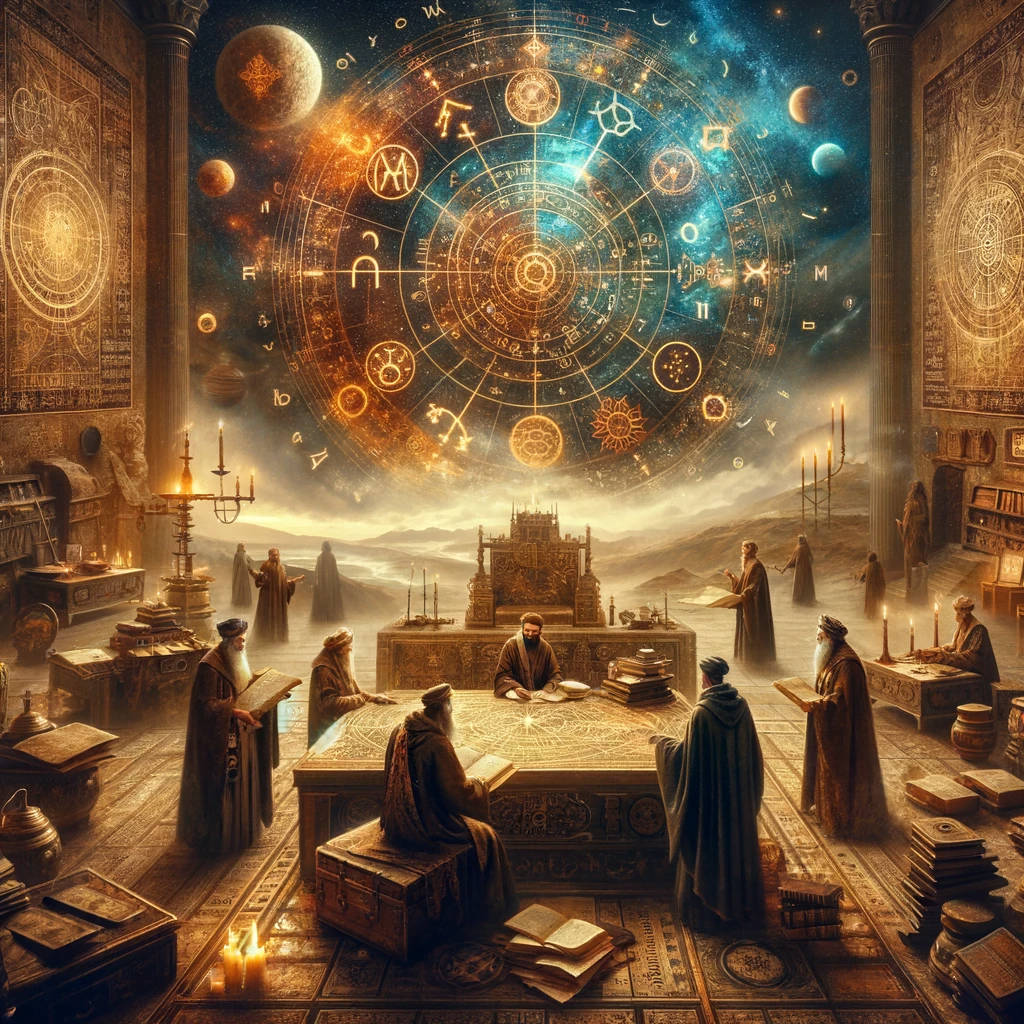Esoteric astrology is the study of the symbolic spiritual meanings behind planetary placements and alignments, unlike mainstream exoteric astrology which aims to predict future events and circumstances. Esoteric astrology focuses on gaining self-insight into inner potential and spirituality using astrological charts as a tool for meditation and reflection. But where did this contemplative practice originate, let´s dive in on the topic of Where Does Esoteric Astrology Originate From!
The First Traces of Esoteric Astrology
The earliest origins of esoteric astrology can be traced back thousands of years to ancient mystics and sages in cultures like Egypt, India, China and others. These mystics studied the night sky not just to track seasons or predict mundane events, but to discern spiritual messages about human existence encoded in the cosmic dance of the planets and stars.
- In India, rishis and yogis dating back to the Vedic period saw intimate connections between Jyotish astrology and the inner world of consciousness and meditation. They developed astrology as a “doorway to the divine” – a sacred science to map the evolution of the soul through karma and dharma.
- In ancient Egypt, learned priest-astrologers studied the cycles of the heavens as a mirror for the soul’s cyclical journey through human life, death and the afterlife. Astrology was integral to their spiritual philosophy and rituals.
- In China, Taoist and Buddhist astrologers incorporated symbolism about the meaning of each planet’s chi energy and the yin/yang balance between them. Their horoscopes analyzed how cosmic energies flow through human lives.
Unlike causal fortune telling astrology, these ancient approaches focused on the deeper soul wisdom and personal growth that could be attained from reading the celestial symbols of the macrocosm and microcosm rather than just external prediction.
Esoteric Astrology in the Hellenistic Period
In the Hellenistic period in Greece and Egypt around the first century BCE to 3rd century CE, philosophers such as Plato, Plotinus, Ptolemy and others incorporated astrological concepts into studies of human nature, metaphysics and divine cosmology. The idea that each visible planet represented a deity-like expression of a particular energy, vital life force or qualitative essence emerged, adding a new spiritual dimension to astrological interpretations.
Key concepts included:
- The connection between celestial movements and the human soul. As above, so below.
- Astrology as elucidating the universal principles and archetypal forces governing material manifestations.
- Each planet embodies a cosmic principle which shapes human affairs.
- The universe as a living organism where all parts are interconnected in cosmic sympathy and synchronicity.
Astrology intermixed with philosophical traditions like:
- Hermeticism – A spiritual tradition aiming to awaken esoteric wisdom and knowledge of one’s divine origin within. Hermetic texts described astrology as mapping the descent of the soul through the celestial spheres into incarnation.
- Neoplatonism – A school teaching the human soul emanates from the Source (God/One) and returns to it after cycles of incarnation on Earth. The motions of the heavens are bound to the soul’s journey.
These cosmologies continued to develop in mystery schools and esoteric traditions during the first centuries of the Common Era.
Development in the Middle Ages
During the European Middle Ages, contacts with Islamic culture resulted in a transmission of astrological teachings back into the West. Medieval astrologers in Persia and Arabia had sythesized Indian, Hellenistic, Hermetic and other streams into sophisticated systems of esoteric thought.
Major figures included:
- Masha’allah ibn Athari – An 8th century Persian astrologer who compiled the meanings of astrological aspects and configurations along with esoteric healing practices and prediction techniques. His works were highly influential.
- Abū Rayḥān al-Bīrūnī – A 10th-11th century polymath who created an early encyclopedia describing astrological concepts from different cultures and relating them to Hermetic, Neoplatonic and Islamic metaphysical ideas.
Meanwhile in Europe, contacts with Jewish esotericism brought Kabbalistic astrology to the cultural fore. Mystics like Avraham Ibn Ezra reinterpreted astrology through a Kabbalistic lens, seeing the planets and stars as symbols for divine emanations and the soul’s path. The infusion of esoteric astrology reached its peak in the late medieval and Renaissance period.
Esoteric Astrology in the Occult Revival
By the 18th century, astrology had fallen out of favor in the West due to the rise of mechanistic science and Enlightenment rationalism. But in the late 19th century, an occult revival in European countries and America renewed wide interest in astrology’s spiritual and divinatory aspects.
Key figures included:
- Helena Blavatsky – Co-founder of the Theosophical Society, she taught esoteric astrology as a key to understanding human spiritual evolution, reincarnation, and the soul’s pilgrimage through cosmic cycles under Karmic law.
- Alan Leo – A prominent British astrologer associated with the Theosophical society. He made esoteric astrology focused on soul growth and free will widely accessible. Wrote one of the first modern books on the topic in 1913.
- Later occultists like Alice Bailey and leaders of the Ascended Master Teachings tradition expanded esoteric astrology greatly, seeing astrological bodies as embodiments of the “Seven Rays” in their elaborate mystical cosmology.
This occult revival planted the seeds for the next phase of development in the 20th century.
Founders and Proponents of Modern Esoteric Astrology
The 20th century saw extensive development and codification of esoteric astrology into new syntheses drawing from the ancient heritage. Some of the most impactful figures include:
- Dane Rudhyar – An immensely influential 20th century astrologer, composer and author. He wrote foundational texts on the spiritual dimensions of astrology and humanistic astrology. Developed concept of transpersonal planets like Uranus, Neptune and Pluto.
- Alice Bailey – A prolific writer and mystic continuing the work of Blavatsky. Outlined an elaborate spiritual hierarchy of rays connected to zodiac signs, planets, and Seven Rays teachings. Very influential on modern esoteric astrology.
- Marc Edmund Jones – Founder of the Sabian Symbols widely used in esoteric astrology. He defined esoteric astrology as revealing the purpose and spiritual meaning of the soul’s journey. Prominent teacher and author.
- Dane Rudhyar – Immensely influential 20th century astrologer who emphasized astrology’s humanistic and transpersonal dimensions. Wrote foundational texts on spiritual astrology. Developed concept of transpersonal planets.
- Alan Oken – Prolific author on esoteric astrology since the 1970s up to the present. Teacher of soul-centered astrology focused on meditation and spiritual growth.
- Stephen Arroyo – Contemporary astrologer specializing in chart interpretation as a tool for conscious evolution of body, emotions, and soul. Combines esoteric and therapeutic approaches.
And many other teachers have expanded esoteric astrology in the 20th-21st centuries.
Differences Between Esoteric and Exoteric Astrology
What primarily distinguishes esoteric astrology from popular ‘sun sign’ newspaper astrology is the core focus:
- Exoteric astrology focuses on prediction of external circumstances, tangible events, and visible causality using zodiac signs, planets, houses, and aspects. It seeks to predict concrete life events.
- Esoteric astrology focuses on supporting inner spiritual development by mapping the evolution and growth of the soul. It sees planet placements as archetypal drivers of one’s unique path in this life.
Some key differences in approach and interpretation:
| Exoteric Astrology | Esoteric Astrology |
|---|---|
| Interpreting astrological symbols as representing fated events | Seeing astrology as revealing spiritual potentials we actualize through free will |
| Reads birth chart as static snapshot | Sees birth chart as beginning of ongoing soul development |
| Predicts external fortunes, circumstances, events | Reveals inner purpose, direction of spiritual growth |
| Emphasizes mandated outcomes from planets | Emphasizes archetypal energies which shape experience |
| Intellectual analysis of chart | Uses chart symbolism for meditation and reflection |
| Sees human as subject to planets | Sees human as cocreator with the cosmos |
| Focuses on prediction of concrete manifestation | Focuses on understanding drivers of spiritual development |
There are also techniques unique to esoteric astrology like occultation charts for spiritual timing and retrograde initiation analysis.
Key Principles of Esoteric Astrology
Some core principles of esoteric astrology include:
- Astrology as Sacred Science of Soul Development – The birth chart reveals the unique path, potentials, and challenges for one’s spiritual growth in this lifetime. It provides a map for the soul’s journey through cycles of incarnation.
- Planets as Archetypal Drivers – Planetary placements represent energetic potentials and challenges to actualize specific qualities, virtues, and capacities. Planets are seen as archetypal drivers of growth rather than external causal forces.
- Chart as Evolutionary Map – The natal chart provides a symbolic map of the key themes, tests, and lessons of the evolving soul in this incarnation. It shows the path one is becoming, not what one is fated to be.
- Astrological Symbolism – The language of astrological signs, planets, houses etc. speaks in archetypes, mythology, and metaphor about the human spiritual condition. It must be interpreted symbolically rather than concretely.
- Evolution Through Aspects – Major developmental stages are shown by aspects between planets over the life span. The birth chart is only the starting point.
- Self-Actualization of Potentials – The natal promise of the chart is activated through life experience and crises which accelerate spiritual growth. Astrological events turn potential into actualization.
- Modern Rulerships – Modern planets like Uranus, Neptune, and Pluto reveal the transpersonal and collective dimensions of the chart.
- Cycles and Progressions – Our journey unfolds through progressive cycles revealed in transits, progressions, and directions. The natal chart is a seed.
The Role of Meditation in Esoteric Astrology
Unlike causal astrology, esoteric astrology places great emphasis on using intuition, reflection, and meditation with astrological charts. Key practices include:
- Reflecting on spiritual meanings of zodiac signs and planet placements in one’s chart during meditation.
- Using visualization, mantras, and rituals based on natal planets to evoke higher states of consciousness and unleash spiritual potentials.
- Cultivating intuition and inner sight to interpret charts at a symbolic soul level rather than just intellectual analysis.
- Understanding astrological transits and progressions as a mirror for inner development through contemplation and journaling.
- Astrological meditation unlocks deeper layers of soul insight compared to mental analysis alone.
- Meditation brings chart symbols alive experientially so their messages emerge intuitively.
Esoteric astrologers do not see the chart as fixed and external to the self, but rather an oracle for inner exploration of the psyche and soul through meditative perception.

Modern Schools of Esoteric Astrology
Today there are many branches of esoteric astrology with different philosophies and techniques. Some major modern schools include:
- Soul-Centered astrology in the theosophical tradition emphasizes reincarnation, karma, spiritual hierarchy, and the evolution of consciousness through the zodiac journeys.
- Archetypal astrology focuses on universal mythic motifs, archetypes, and primal patterns connected to the planets and signs. It moves away from prediction.
- Cosmobiology developed by Reinhold Ebertin teaches that karmic patterns can be Modified by consciously working with astrological energies.
- Transpersonal astrology centers on modern outer planets as indicators of spiritual development, especially Uranus, Neptune, and Pluto.
- Humanistic astrology sees astrology as a path to self-realization and the development of human potential. Focuses on free will more than fate.
- And many more modern branches like evolutionary astrology continue to emerge and synthesize ancient teachings in new ways…
Conclusion
Esoteric astrology has rich roots spanning thousands of years, with foundations in ancient mystery traditions, Hermeticism, and 19th century occult revivals. While exoteric astrology focuses on prediction, esoteric astrology aims to map the soul’s spiritual journey in this life and beyond using astrological symbolism as an oracle for inner wisdom.
With so many schools of thought evolving today, our understanding of astrology’s esoteric dimensions continues to grow. By taking a contemplative approach, we can reflect on the stories the heavens tell about who we are, where we came from, and where we are going. The cosmic journey continues…



